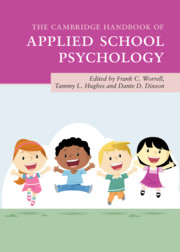Book contents
- The Cambridge Handbook of Applied School Psychology
- The Cambridge Handbook of Applied School Psychology
- Copyright page
- Contents
- Contributors
- Contributor Biographies
- Acknowledgments
- 1 Broadening the Focus of School Psychology Practice
- Part I Individual-Level Academic Interventions
- Part II Teacher- and System-Level Interventions
- Part III Interventions from Educational and Social/Personality Psychology
- Part IV Behavioral and Social-Emotional Interventions
- Part V Health and Pediatric Interventions
- 26 Impairments Related to Medical Conditions
- 27 Psychological Considerations for Asthma
- 28 Substance Use and Misuse Prevention: Guidance for Practitioners
- 29 Coordinating Services with Nonschool Providers
- Part VI Family Connections and Life Transitions
- Part VII Special Populations
- Part VIII Conclusion
- Index
- References
27 - Psychological Considerations for Asthma
from Part V - Health and Pediatric Interventions
Published online by Cambridge University Press: 18 September 2020
- The Cambridge Handbook of Applied School Psychology
- The Cambridge Handbook of Applied School Psychology
- Copyright page
- Contents
- Contributors
- Contributor Biographies
- Acknowledgments
- 1 Broadening the Focus of School Psychology Practice
- Part I Individual-Level Academic Interventions
- Part II Teacher- and System-Level Interventions
- Part III Interventions from Educational and Social/Personality Psychology
- Part IV Behavioral and Social-Emotional Interventions
- Part V Health and Pediatric Interventions
- 26 Impairments Related to Medical Conditions
- 27 Psychological Considerations for Asthma
- 28 Substance Use and Misuse Prevention: Guidance for Practitioners
- 29 Coordinating Services with Nonschool Providers
- Part VI Family Connections and Life Transitions
- Part VII Special Populations
- Part VIII Conclusion
- Index
- References
Summary
Asthma is increasing in prevalence in school-aged children. Causes for it include psychological triggers such as anxiety, stress, and depression. Interventions that are derived from education and psychology appear promising for symptom reduction. These treatments include written emotional expression, relaxation and guided imagery, gratitude exercises, mindfulness, and yoga, amongst others. This chapter reviews the myriad causes and treatments for childhood asthma.
Keywords
- Type
- Chapter
- Information
- The Cambridge Handbook of Applied School Psychology , pp. 471 - 480Publisher: Cambridge University PressPrint publication year: 2020

